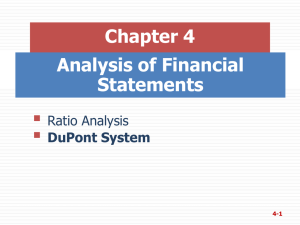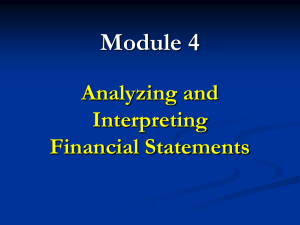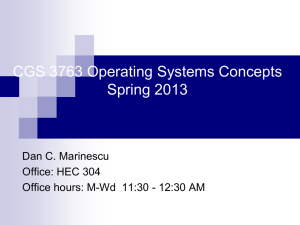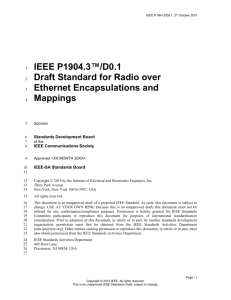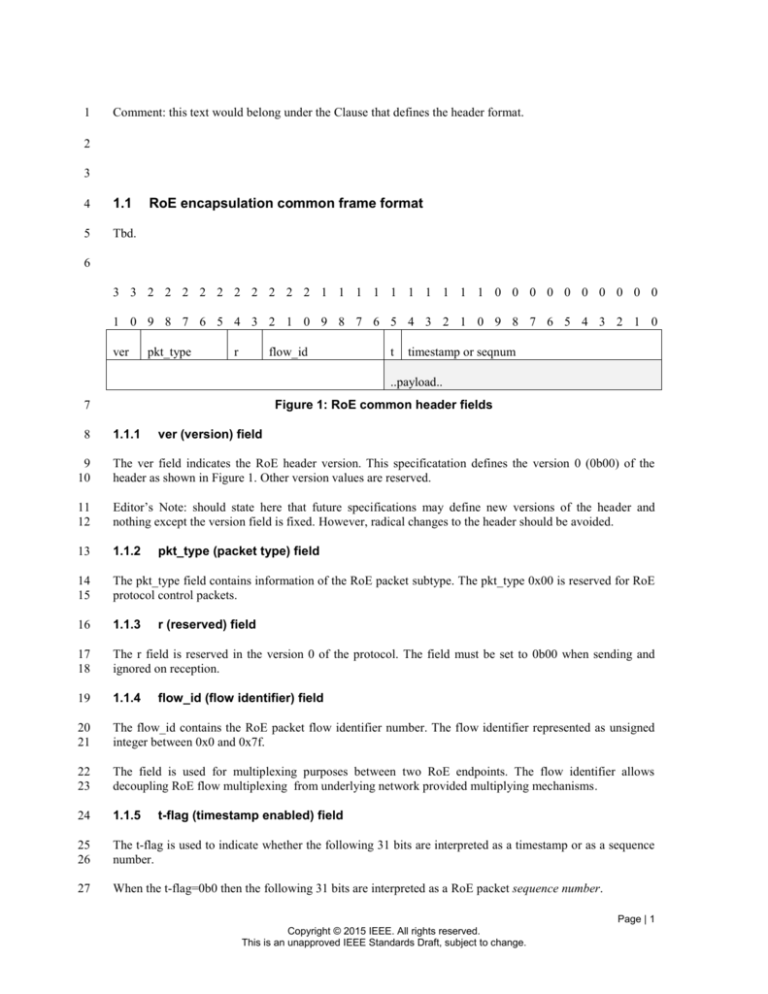
1
Comment: this text would belong under the Clause that defines the header format.
2
3
4
1.1
5
Tbd.
RoE encapsulation common frame format
6
3 3 2 2 2 2 2 2 2 2 2 2 1 1 1 1 1 1 1 1 1 1 0 0 0 0 0 0 0 0 0 0
1 0 9 8 7 6 5 4 3 2 1 0 9 8 7 6 5 4 3 2 1 0 9 8 7 6 5 4 3 2 1 0
ver
pkt_type
r
flow_id
t
timestamp or seqnum
..payload..
Figure 1: RoE common header fields
7
8
1.1.1
ver (version) field
9
10
The ver field indicates the RoE header version. This specificatation defines the version 0 (0b00) of the
header as shown in Figure 1. Other version values are reserved.
11
12
Editor’s Note: should state here that future specifications may define new versions of the header and
nothing except the version field is fixed. However, radical changes to the header should be avoided.
13
1.1.2
14
15
The pkt_type field contains information of the RoE packet subtype. The pkt_type 0x00 is reserved for RoE
protocol control packets.
16
1.1.3
17
18
The r field is reserved in the version 0 of the protocol. The field must be set to 0b00 when sending and
ignored on reception.
19
1.1.4
20
21
The flow_id contains the RoE packet flow identifier number. The flow identifier represented as unsigned
integer between 0x0 and 0x7f.
22
23
The field is used for multiplexing purposes between two RoE endpoints. The flow identifier allows
decoupling RoE flow multiplexing from underlying network provided multiplying mechanisms.
24
1.1.5
25
26
The t-flag is used to indicate whether the following 31 bits are interpreted as a timestamp or as a sequence
number.
27
When the t-flag=0b0 then the following 31 bits are interpreted as a RoE packet sequence number.
pkt_type (packet type) field
r (reserved) field
flow_id (flow identifier) field
t-flag (timestamp enabled) field
Page | 1
Copyright © 2015 IEEE. All rights reserved.
This is an unapproved IEEE Standards Draft, subject to change.
1
When the t-flag=0b1 then the following 31 bits are interpreted as a timestamp.
2
1.1.6
3
Tbd.
4
1.1.6.1
5
6
The timestamp field is actually a 31 bit presentation time of the packet at the receiver. The use of
timestamp de-couples RoE flow play-out time from network transit time
7
8
The reference time is defined to be the International Atomic Time (TAI). The timestamp is in nanoseconds
and allows expressing a presentation time 2 seconds to the future.
9
10
The timestamp in the RoE header is formed as follows. The actual system time, is for example, taken from
the 1588 time. The example below assume 1588 time:
11
1588_time = 1588_current_time + constant_latency_time + dejitter_time;
12
13
timestamp = 1588_time.nanosecondsField & 0x3fffffff |
(1588_time.secondsField & 1) << 30;
14
15
The contant latency time represents the oneway network delay and the required de-jitter delay at the
receiver. How the delay is actually measured is outside of scope of this specification.
16
Tbd.
17
1.1.6.2
18
19
20
21
The seqnum is a 31 bits packet sequence number field. The sequence number counter is increased by one
on every sent packet, also when the t-flag=0b1and the 31 bits field actually carries a timestamp. The
seqnum is initialized to 0. This field is to wrap from 0b1111111111111111111111111111111 to
0b0000000000000000000000000000000 (0x7F-FF-FF-FF to 0x00-00-00-00).
22
1.1.7
23
The payload field content is dependant on the RoE packet subtype.
24
1.2
25
Tbd.
Timestamp and sequence number fields
timestamp
seqnum
Payload
Allocated pkt_type values
26
Table 1: RoE packet subtype values
27
pkt_type in hexadecimal
0x00
Function
Control packet
0x01
Structure agnostic packet
0x02
0x03
Antenna flow
Vendor specific flow
Meaning
The payload carries TLVs for
control purposes. N
The content of the payload is
unknown at the RoE protocol
level. Only the application at
using the RoE transport know
interpret the payload content.
tbd.
tbd.
Page | 2
Copyright © 2015 IEEE. All rights reserved.
This is an unapproved IEEE Standards Draft, subject to change.
0x04
0x05
Antenna control
Slow C&M
tbd.
tbd.
1
2
Page | 3
Copyright © 2015 IEEE. All rights reserved.
This is an unapproved IEEE Standards Draft, subject to change.




